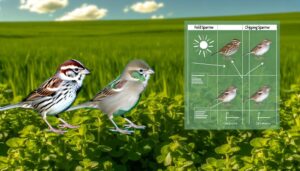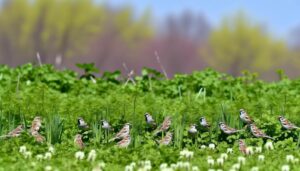10 Common Sparrows in Alabama You Should Know
Common sparrow species in Alabama include the Chipping Sparrow, known for its reddish cap and black eyeline, and the Song Sparrow, identifiable by its streaked, brown plumage. The White-throated Sparrow, with its distinctive throat, and the Field Sparrow, with its un-streaked chest, are also frequently spotted.
Finally, the vibrant Eastern Towhee adds to the state's avian diversity. Each species holds a unique role in Alabama's ecosystem, from controlling pests to dispersing seeds.
Understanding these species' features provides a glimpse into their fascinating individual roles. For a more detailed look, exploring each species' thorough profile would be enlightening.

Key Takeaways
- Chipping Sparrows, recognizable by their reddish cap and black eye-line, are common in Alabama's open woodlands and residential areas.
- Song Sparrows, known for their streaky brown plumage and melodious songs, adapt well to diverse habitats across Alabama.
- The White-throated Sparrow, with its distinctive white throat and black head stripes, is easily recognizable and prefers Alabama's shrubby areas.
- Field Sparrows, known for their reddish-brown upper parts and un-streaked chest, are commonly found in Alabama's shrubby fields and grasslands.
- Eastern Towhees, identifiable by their vibrant plumage, are also common in Alabama, with males having black upper bodies and females featuring warm brown.
Understanding Sparrows in Alabama
In Alabama, one can't help but notice the prevalence and variety of sparrows, these small, plump, brown and grey birds that play an important role in the state's ecosystem.
They're often seen flitting about in gardens, parks, and woodlands, their chirping song a familiar soundtrack to the state's natural landscape. Sparrows contribute to the biodiversity of Alabama, playing a significant role in controlling insect populations, and acting as pollinators for many native plants.
They're also a vital food source for predators, such as hawks and snakes. Importantly, there are several different species of sparrows in Alabama, each with its own unique behaviors and characteristics, contributing to the rich tapestry of the state's avian life.
The Chipping Sparrow Profile
First on our list is the Chipping Sparrow, a common sight in Alabama, known for its distinctive reddish cap, black eye-line, and grey underparts. This small and delicate bird is easily identifiable by these unique features.
To further illustrate the Chipping Sparrow, here are some additional details:
- *Size and Shape*: Measuring about 5-6 inches long, it's a slender bird with a fairly long, forked tail.
- *Habitat*: They're typically found in open woodlands and edges, often near residential areas.
- *Behavior*: They're ground feeders, often seen hopping about under the shrubs or on lawns pecking for food.
Understanding the Chipping Sparrow's profile aids in appreciating Alabama's rich avian biodiversity. Such knowledge sharpens our observational skills, fostering a deeper connection with our environment.
Spotlight on the Song Sparrow
Switching our focus to another common resident of Alabama, we'll now explore the Song Sparrow, a melodious bird that's as appealing to the ear as it's to the eye.
The Song Sparrow, scientifically known as Melospiza melodia, has a typical length of 4.3–7.1 inches and weight ranging from 0.4–1.9 oz. It's often recognized by its streaky brown plumage and rounded tail. This species stands out for its varied and melodious song repertoire, ideal for auditory identification.
It's a hardy bird, adapting to diverse habitats including marshes, fields, and urban areas. It primarily feeds on insects and seeds, often foraging on the ground. Known for being territorial, it's common to see a Song Sparrow perched on a low shrub, singing its distinctive tune while defending its space.
The White-throated Sparrow Unveiled
Turning the lens towards the White-throated Sparrow, one notices distinctive identification features such as its bright white throat, contrasting black stripes on its head, and a yellow spot between the eye and bill.
Preferring to inhabit shrubby areas in forests or residential gardens, this sparrow exhibits a unique behavior of feeding on the ground while hopping forward with both feet.
Its song, a whistling 'Oh Sweet Canada Canada Canada', becomes a memorable marker of its presence.
Identification Features
Amid the diverse bird species of Alabama, the White-throated Sparrow stands out with its distinctive physical attributes and unique markings. This common sparrow can be easily recognized by keen bird watchers and amateurs alike.
To identify a White-throated Sparrow, observe these specific features:
- A striking head pattern: The bird is marked by a prominent white throat, bordered by a sharp black bib. It also sports a yellow lore spot between their eye and beak.
- Unique plumage: It exhibits a grayish-brown upper body and a dingy white underparts.
- Size and shape: It's of medium size, with a full, rounded body, a long tail, and a fairly small bill.
These distinguishing traits make the White-throated Sparrow unmistakable amidst Alabama's avian diversity.
Habitat and Behavior
While the distinctive features of the White-throated Sparrow make it a standout, its habitat and behavior offer further fascinating insights into this common Alabama avian resident.
Often found in forested areas and scrubby habitats, they're partial to thickets and shrubs. They've adapted to human-altered environments too, showing up in parks and gardens.
In their quest for food, these sparrows forage on the ground, scratching away leaf litter to reveal seeds, insects, and berries. Mating rituals are intriguing: males court females with a soft song and display flight.
During winter, they often form flocks, feeding and roosting together. These behaviors, coupled with their adaptability, contribute to the White-throated Sparrow's success in Alabama's varied landscapes.
Features of the Field Sparrow
The Field Sparrow, identified scientifically as Spizella pusilla, presents a distinct appearance that sets it apart within the avian community of Alabama.
This species is characterized by its reddish-brown upper parts, pink bill and un-streaked grayish chest and belly, offering a unique visual spectacle for keen bird watchers.
Additionally, the Field Sparrow's habitat preferences, mainly shrubby fields and grasslands, provide a relevant context for understanding its behavioral patterns and survival adaptations.
Field Sparrow Appearance
Sporting a distinctive pink bill and a grayish-brown coat, the Field Sparrow stands out among Alabama's common sparrows with its unique physical characteristics. This small songbird, typically 4.7 to 5.5 inches in length, exhibits a noticeably round head and a relatively long, forked tail.
The underparts of the Field Sparrow are clear, with a whitish color that subtly contrasts with its brownish upperparts.
The bird's eyes are strikingly large and are a dark, reddish-brown color.
Juvenile Field Sparrows differ slightly in appearance, showcasing streaks on their breast and flanks.
This description showcases the bird's elegant simplicity. The Field Sparrow's modest but distinctive features make it an easily identifiable species within Alabama's avian community.
Field Sparrow Habitat
Moving from physical traits to environmental preferences, Field Sparrows typically inhabit open, shrubby country including old fields, pastures, and edges of woods. This preference for a diverse array of habitats enables them to adapt to changes in natural landscapes.
However, they do show a particular affinity for early-successional habitats and abandoned farmlands. These environments provide dense low vegetation where they can nest and find food. Field Sparrows feed primarily on seeds and insects, so habitats rich in these resources are particularly attractive.
It's worth noting they aren't exclusive to rural areas; they're also found in suburban regions where appropriate habitat exists. Understanding the habitat preferences of Field Sparrows is key to their conservation in Alabama.
The Endearing Eastern Towhee
In Alabama's lush landscapes, you'll often encounter the Eastern Towhee, a sparrow species that captivates with its vibrant plumage and unique, distinctive call. This bird is an alluring sight with striking features that are hard to miss.
The male Eastern Towhee sports a black head, neck, and upper body, contrasting sharply with its rufous sides and white belly.
Females exhibit a similar pattern but with a warm brown replacing the black.
Their call, a distinctive 'drink-your-tea', is a melody often heard in Alabama's forests and thickets.
The Eastern Towhee's behavior is as interesting as its appearance. It forages on the ground, often scratching the leaf litter in a unique, backward hop.
This distinctive, entertaining sparrow certainly adds a splash of color and song to Alabama's diverse bird community.
Importance of Sparrows in Ecosystem
While the Eastern Towhee's distinctive features and behaviors add charm to Alabama's bird community, it's worth noting how sparrows, in general, play an intricate role in maintaining ecological balance. These small birds are significant contributors to natural pest control, feeding on a variety of insects. They also disperse seeds, aiding plant propagation. Sparrows' nests provide shelter for other small creatures, and their eggs and young serve as food for larger predators, thereby supporting biodiversity.
| Ecosystem Function | Sparrow Role | Example |
|---|---|---|
| Pest Control | Sparrows eat insects | Reducing harmful insect populations |
| Seed Dispersal | Sparrows spread seeds | Enhancing plant diversity |
| Providing Shelter | Sparrows' nests house small creatures | Supporting microhabitat diversity |
| Food Source | Sparrows are prey for larger predators | Promoting biodiversity |
Conclusion
In the grand tapestry of Alabama's wildlife, sparrows hold a pivotal role. These small, feathered troubadours, as timeless as a gramophone tune, add a charming melody to the landscape.
From the rustic Chipping Sparrow to the eloquent Eastern Towhee, their roles in pest control and seed dispersion are invaluable.
Understanding and appreciating these common sparrows leads to a richer, more harmonious relationship with our environment.
Indeed, in the concert of nature, Alabama's sparrows hit all the high notes.






